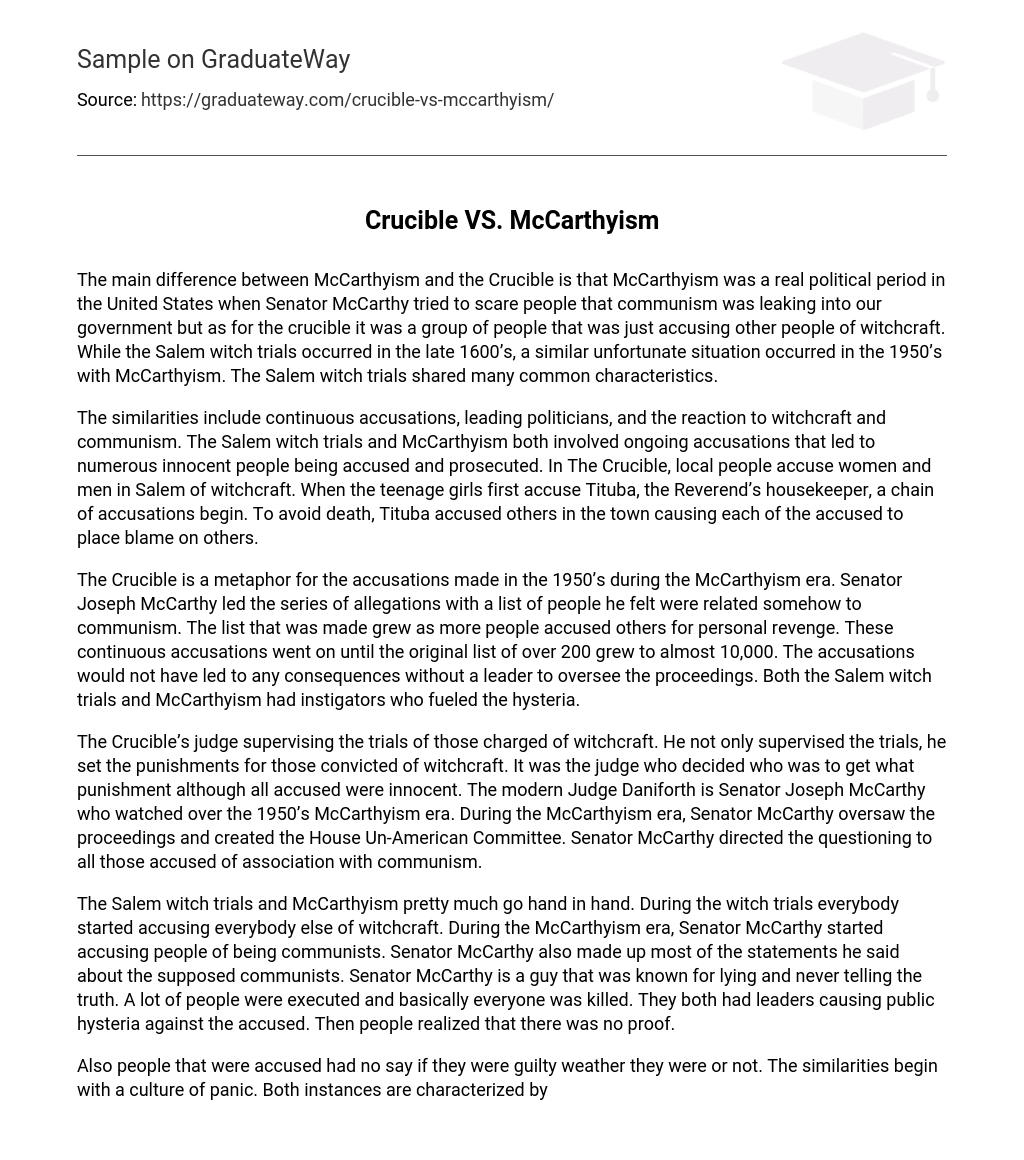The Crucible and McCarthyism had the same core concept; however, McCarthyism was a genuine political era in America where Senator McCarthy aimed to instill fear that communism was infiltrating the government. On the other hand, the Crucible revolved around a group of individuals accusing others of witchcraft. Despite the Salem witch trials taking place in the 1600s, a comparable unfortunate situation transpired in the 1950s with McCarthyism. Both instances exhibited many similarities.
Both the Salem witch trials and McCarthyism had similarities which included constant accusations, involvement of prominent politicians, and the response towards witchcraft and communism. In The Crucible, individuals in Salem are accused of practicing witchcraft by their own community members. This chain of accusations was triggered when teenage girls pointed fingers at Tituba, the housekeeper of the Reverend. In order to save herself from death, Tituba started accusing others in the town, leading to a cycle where each accused person would then blame someone else.
The Crucible serves as a symbol of the accusations that occurred in the 1950’s during the McCarthyism era. Senator Joseph McCarthy spearheaded the allegations by providing a list of individuals he believed had some connection to communism. This list expanded as more people accused others out of personal vendettas. The relentless accusations persisted until the initial list of over 200 names multiplied to nearly 10,000. Without a leader to supervise the proceedings, these accusations would not have resulted in any consequences. Both the Salem witch trials and McCarthyism had instigators who fueled the widespread panic.
The Crucible’s judge oversaw the trials and determined the punishments for those accused of witchcraft. He decided the appropriate punishment for each individual, even though they were all innocent. In modern times, Judge Daniforth represents Senator Joseph McCarthy, who played a similar role during the McCarthyism era in the 1950s. Senator McCarthy supervised the proceedings and established the House Un-American Committee, where he questioned individuals suspected of having connections to communism.
The Salem witch trials and McCarthyism are closely connected. In both instances, accusations of wrongdoing were rampant. During the witch trials, everyone accused one another of practicing witchcraft. Similarly, in the McCarthyism era, Senator McCarthy accused individuals of being communist sympathizers. It is worth noting that Senator McCarthy was notorious for fabricating statements about alleged communists. His credibility was questionable, as he was known for dishonesty. Sadly, many people lost their lives during these periods of mass hysteria. However, eventually it became evident that there was no substantial evidence to support the accusations.
The accused in both instances lacked the opportunity to defend themselves, irrespective of their actual guilt. The common factor lies in a culture dominated by fear. The Salem Witch Trials arose from a collective endeavor to identify witches prompted by panic. Similarly, Senator McCarthy pursued a quest to expose communists and mobilized an alarmed public. The resulting frenzy in Salem led to numerous allegations of witchcraft and subsequent executions. Likewise, McCarthyism thrived on hysteria as people accused others of affiliations with Communism. Both situations were propelled by a climate of suspicion and widespread fear.
The McCarthy Hearings and the Salem witch trials were seen as similar in nature, often being referred to as “witch hunts.” Both events instilled fear among the people by adopting an attitude of presumption of guilt until a confession was made, which heavily influenced the courts. In the Salem witch trials, individuals could only escape death by confessing and expressing remorse. Similarly, in the McCarthy hearings, once accused, individuals were consistently labeled as Communists regardless of their guilt or innocence. Drawing a parallel, McCarthy’s actions align with those of Abigail in The Crucible, as both fabricated accusations against innocent individuals. While McCarthy accused people of being communists, Abigail accused individuals of practicing witchcraft.
Although the outcomes and motives varied widely, the central concept of targeting and pursuing individuals who embody contrasting beliefs remains consistent. In both scenarios, authorities sought to hold certain individuals accountable for their own anxieties and insecurity. The Salem witch trials, for instance, involved the wrongful accusation of residents from a specific area of town as witches, not due to any involvement in witchcraft, but because they or their families owned valuable land that the accusers, their superiors, or acquaintances sought to acquire at a bargain.
Associating the land with witchcraft significantly reduced its value. In the event of witchcraft conviction, both the woman and her family could lose their property, making it more accessible for those looking to acquire it. Senator McCarthy successfully formed a senate commission to examine the proliferation of communism in the United States, with specific attention directed towards the entertainment industry.
Their ability to perform or earn a living under their own names was effectively ended when they were blacklisted by the industry to appease McCarthy’s perceived political leaders. Citations can be found on WikiAnswers, Salem Witch Trials & McCarthyism website, and English 11 website.





